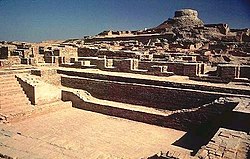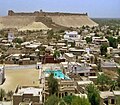Harappan architecture is the architecture of the Bronze Age Indus Valley civilization, an ancient society of people who lived during c. 3300 BCE to 1300...
18 KB (2,215 words) - 00:39, 27 December 2024
to use fired "terracotta" brick instead. A prominent feature of Harappan architecture was also the first use anywhere in the world of English bond in...
52 KB (5,534 words) - 22:16, 21 May 2025
civilisation or Harappan civilisation, a Bronze Age civilisation that throve along Indus River c. 3300 – c. 1700 BC Harappan architecture of the ancient...
609 bytes (115 words) - 00:52, 21 July 2024
Indus Valley Civilisation (redirect from Harappan Civilisation)
Ghaggar-Hakra, a seasonal river in northwest India and eastern Pakistan. The term Harappan is sometimes applied to the Indus Civilisation after its type site Harappa...
188 KB (21,172 words) - 13:05, 6 May 2025
The Harappan language is the unknown language or languages of the Bronze Age (c. 3300 to 1300 BC) Harappan civilization (Indus Valley civilization, or...
14 KB (1,197 words) - 23:10, 27 May 2025
megaron 1000s BC – 1100s – 1200s – Chogha Zanbil built. End of Harappan architecture 1300s – 1400s – 1500s – 1600s – Final construction of Stonehenge...
56 KB (5,087 words) - 10:22, 15 April 2025
Valley civilization the architecture also suffered considerable damage. Little is known about this civilization, often called Harappan, partly because it disappeared...
35 KB (3,491 words) - 12:51, 7 May 2025
Kalibangan (section Early Harappan Phase)
called "Early Harappan or antecedent Harappan". Other nearby sites belonging to IVC include Balu, Kunal, Banawali etc. This Early Harappan phase (also called...
34 KB (4,564 words) - 11:55, 18 March 2025
The Architecture of Gujarat consists of architecture in the Indian state of Gujarat. The first major civilization in Gujarat was the Harappan Civilization...
20 KB (2,019 words) - 09:28, 24 May 2025
Mohenjo-daro some years later. For this reason, IVC is sometimes called the "Harappan civilisation," a term more commonly used by the Archaeological Survey of...
25 KB (2,633 words) - 16:14, 24 May 2025
Pearson Education. pp. 151–155. ISBN 978-81-317-1120-0. "Dholavira: a Harappan City". UNESCO World Heritage Centre. Retrieved 2022-01-14. Singh, Upinder...
8 KB (908 words) - 15:16, 8 May 2025
engraving on a piece of red potsherd, discovered at Bhirrana, India, a Harappan site in Fatehabad district in Haryana, shows an image that is evocative...
15 KB (1,533 words) - 14:25, 29 May 2025
Indus script (redirect from Harappan script)
The Indus script, also known as the Harappan script and the Indus Valley script, is a corpus of symbols produced by the Indus Valley Civilisation. Most...
65 KB (6,446 words) - 04:07, 30 May 2025
the stretchers, and perpends in each alternate course aligned. Harappan architecture in South Asia was the first use, anywhere in the world, of so-called...
26 KB (2,879 words) - 01:00, 26 December 2024
Amri, Sindh (section Pre-Harappan stage)
indigenous culture which had common elements, later they came in contact with Harappan culture and fully developed into mature phase of Indus Valley Civilisation...
7 KB (729 words) - 16:04, 30 May 2025
The history of architecture traces the changes in architecture through various traditions, regions, overarching stylistic trends, and dates. The beginnings...
186 KB (21,188 words) - 12:47, 26 May 2025
(Kathmandu Valley)"; Journal of Asian Architecture and Building Engineerng 59, May 2005. T.S. SUBRAMANIAN, Harappan surprises. 13 June 2014 – www.frontline...
42 KB (4,675 words) - 18:32, 25 May 2025
the trend for Hindu interpretations of archaeological evidence from the Harappan sites was that of John Marshall, who in 1931 identified the following as...
55 KB (5,917 words) - 21:39, 22 May 2025
Hindu temple architecture and Indo-Islamic architecture, especially Rajput architecture, Mughal architecture, South Indian architecture, and Indo-Saracenic...
188 KB (21,063 words) - 13:32, 18 May 2025
Bhirrana (section Period IB: Early Harappan Culture)
efforts to legitimate the Hindutva ideology which identifies the ancient Harappans (incorrectly) with the Vedas and Sanskrit, in order to synthesize the...
28 KB (2,836 words) - 21:31, 28 May 2025
Dholavira (section Architecture)
Dholavira's location is on the Tropic of Cancer. It is one of the five largest Harappan sites and the most prominent of archaeological sites in India belonging...
27 KB (2,743 words) - 13:07, 2 May 2025
c. 1300 BC – End of Harappan architecture. Ramesses II expands Luxor Temple. Abu Simbel constructed. Chogha Zanbil built v t e...
532 bytes (21 words) - 04:42, 18 March 2025
Periodisation of the Indus Valley Civilisation (redirect from Pre-Harappan)
the Indus Valley Civilisation was divided into Early, Mature, and Late Harappan by archaeologists like Mortimer Wheeler, newer periodisations include the...
27 KB (2,793 words) - 03:04, 24 January 2025
Lothal (section Later Harappan culture)
Sabarmati River on the trade route. This trade route stretched between Harappan cities in Sindh (Pakistan) and the peninsula of Saurashtra where the surrounding...
53 KB (6,430 words) - 21:23, 25 May 2025
Bargaon (archaeological site) (section Late Harappan)
Saharanpur District, Uttar Pradesh, India. This site belongs to the late Harappan period, with a mixture of Ochre Coloured Pottery. Indus Valley civilization...
1 KB (82 words) - 16:22, 16 March 2025
the Indus Valley civilisation, being part of the pre-Harappan (6000?/4600-3300 BCE), early Harappan (3300-2600 BCE), and the mature phase (2600-1900 BCE)...
49 KB (5,121 words) - 14:49, 28 May 2025
Number of Indus script inscribed objects and seals obtained from various Harappan sites: 1540 from Mohanjodaro, 985 from Harappa, 66 from Chanhudaro, 165...
79 KB (8,174 words) - 11:42, 26 May 2025
common elements, later they came in contact with Harappan culture and fully developed into Harappan culture. Earliest examples of artifacts belonging...
14 KB (1,616 words) - 13:39, 7 May 2025
culture / subculture. This culture is a pre-Harappan culture which was contemporaneous with the Early-Harappan culture, with which it had trade and/or social...
12 KB (1,293 words) - 12:12, 18 March 2025
Banawali (section Architecture)
I: Pre-Harappan (Kalibangan)(c.2500-2300 BCE) Period IA: Pre-defence Phase Period IB: Defence Phase Period IC: Transitional Phase (Proto-Harappan) Period...
11 KB (1,224 words) - 11:11, 11 March 2025





















